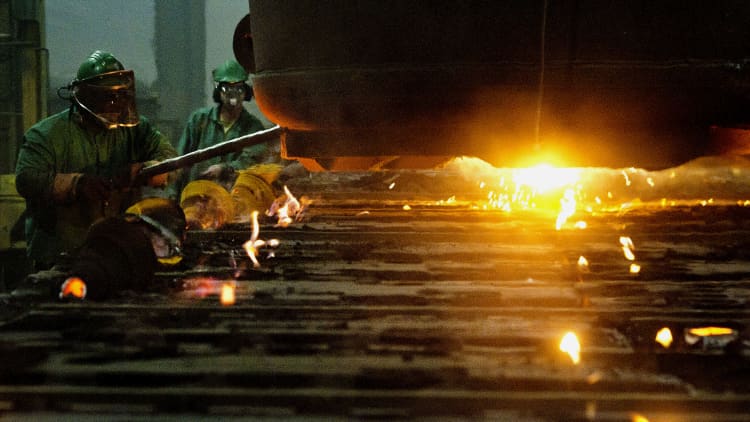
Within Friday's pedestrian reading on first-quarter growth came some real evidence that money is being put to work and could trigger growth.
GDP started the year by advancing 0.7 percent, a weak reading that was below consensus of 1.2 percent but actually better than some of the more pessimistic forecasts coming out of Wall Street in recent days.
Within the numbers, though, there was an interesting story that gives hope for better days.
Private investment, which has languished through much of the recovery, spiked to start the year. In doing so, it provided one of the first signs that the soft data of powerful sentiment readings from businesses, investors and consumers were translating into some tangible action in hard data.
"We're certainly seeing an improvement in business investment," said Joseph LaVorgna, chief U.S. economist at Deutsche Bank. "That does suggest that some of the animal spirits that are showing up in softer data are actually coming through in these GDP numbers."
The most-watched indicator regarding business spending is nonresidential private investment, a capital expenditures barometer that surged 9.4 percent for the first three months. Investment in structures jumped 22.1 percent and equipment rose a similarly strong 9.1 percent, according to figures from the Bureau of Economic Analysis.
The capex number was the best going back to the fourth quarter of 2013.
Economists attributed the investment surge to spending by energy companies in equipment and structures.
"The guts within the GDP report were stronger than the headline implies," Michelle Meyer, U.S. economist at Bank of America Merrill Lynch, said in a note. Meyer characterized investment as "quite robust," though she noted that a 13.7 percent gain in residential investment could have come due to warmer-than expected-weather, particularly in February.
Meyer said she expects more robust growth through the rest of the year, buttressing forecasts from Goldman Sachs earlier this week that GDP in the next two quarters should average around 2.7 percent.
There were additional signs of a swing in activity.
The Employment Cost Index, believed to be a favorite indicator for Fed Chair Janet Yellen, showed a quarterly increase of 0.8 percent and an annualized gain of 2.4 percent, significantly higher than the 1.9 percent gain of a year ago.
The central bank is looking for signs of inflation both as a sign of economic activity and a tightening labor market.
Inflation indicators overall for the month were mixed. Personal consumption expenditures increased just 0.3 percent for the quarter. But the PCE price index rose 2.4 percent, or 2.0 percent excluding food and energy, about in line with Fed inflation targets.
Those trends come amid stock market averages that are lingering around all-time highs, and a string of new records set for business deal activity. Volume for cross-border mergers and acquisitions, issuance for investment-grade and high-yield debt, and secondary share issuance for companies that recently went public are all at historical levels, according to data from Thomson Reuters.


